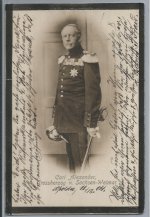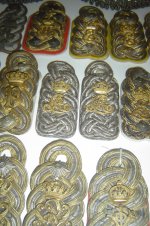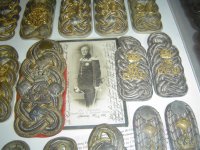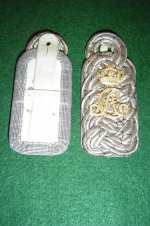ww1czechlegion
Well-known member
Hello,
I need assistance with figuring out the Cipher on the reverse side of this 1930's era veterans flag that belongs to a friend.
Is this a cipher "L" and an "A" or a "U" in the old Gothic script? And if so, who does this cipher combination represent? It's not any of the old Dukes or Grand Dukes from the Duchy of Saxe-Weimar-Eisenach, dating as far back as 1809 with Charles Augustus.
The flag is a 1930's era NSKOV veterans flag for the Kreis District of Eisenach, which of course made up the area of the old Saxe-Weimar-Eisenach.
The border colors on the reverse of the flag are indeed correct for the old Imperial German era Saxe-Weimar-Eisenach: Green-Gold/Yellow-Black
I presume the dates in the corners of the flag are for Napoleonic battle honors that this unit dates back to.
The other side has the NSKOV lettering on a black shield with "Kreis Eisenach" in the upper left corner. And the part I'm not showing has an early, flat 3rd reich emblem on it.
The flag has absolutely gorgeous workmanship on the embroidery.
Thanks in advance for any assistance that anyone can provide here.
Best Wishes,
Alan
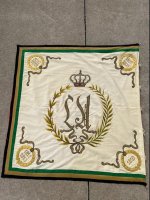
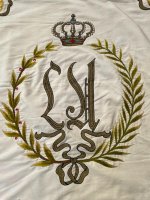
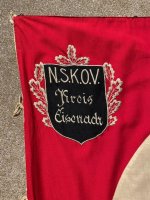
I need assistance with figuring out the Cipher on the reverse side of this 1930's era veterans flag that belongs to a friend.
Is this a cipher "L" and an "A" or a "U" in the old Gothic script? And if so, who does this cipher combination represent? It's not any of the old Dukes or Grand Dukes from the Duchy of Saxe-Weimar-Eisenach, dating as far back as 1809 with Charles Augustus.
The flag is a 1930's era NSKOV veterans flag for the Kreis District of Eisenach, which of course made up the area of the old Saxe-Weimar-Eisenach.
The border colors on the reverse of the flag are indeed correct for the old Imperial German era Saxe-Weimar-Eisenach: Green-Gold/Yellow-Black
I presume the dates in the corners of the flag are for Napoleonic battle honors that this unit dates back to.
The other side has the NSKOV lettering on a black shield with "Kreis Eisenach" in the upper left corner. And the part I'm not showing has an early, flat 3rd reich emblem on it.
The flag has absolutely gorgeous workmanship on the embroidery.
Thanks in advance for any assistance that anyone can provide here.
Best Wishes,
Alan




